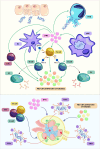Early-onset lupus nephritis
- PMID: 39135943
- PMCID: PMC11318049
- DOI: 10.1093/ckj/sfae212
Early-onset lupus nephritis
Abstract
Early-onset systemic lupus erythematous (SLE) is a distinct clinical entity characterized by the onset of disease manifestations during childhood. Despite some similarities to patients who are diagnosed during adulthood, early-onset SLE typically displays a greater disease severity, with aggressive multiorgan involvement, lower responsiveness to classical therapies, and more frequent flares. Lupus nephritis is one of the most severe complications of SLE and represents a major risk factor for long-term morbidity and mortality, especially in children. This review focuses on the clinical and histological aspects of early-onset lupus nephritis, aiming at highlighting relevant differences with adult patients, emphasizing long-term outcomes and discussing the management of long-term complications. We also discuss monogenic lupus, a spectrum of conditions caused by single gene variants affecting the complement cascade, extracellular and intracellular nucleic acid sensing and processing, and occasionally other metabolic pathways. These monogenic forms typically develop early in life and often have clinical manifestations that resemble sporadic SLE, whereas their response to standard treatments is poor.
Keywords: interferonopathy; lupus nephritis; monogenic lupus; paediatric lupus.
© The Author(s) 2024. Published by Oxford University Press on behalf of the ERA.
Conflict of interest statement
None declared.
Figures



Similar articles
-
Comparison of Clinical Features, Treatment and Outcomes of Lupus Nephritis Between Patients With Late- and Early-Onset Systemic Lupus Erythematosus: A Controlled Study.J Clin Med Res. 2024 Mar;16(2-3):106-117. doi: 10.14740/jocmr5097. Epub 2024 Mar 16. J Clin Med Res. 2024. PMID: 38550544 Free PMC article.
-
Long-term renal survival of paediatric patients with lupus nephritis.Nephrol Dial Transplant. 2022 May 25;37(6):1069-1077. doi: 10.1093/ndt/gfab152. Nephrol Dial Transplant. 2022. PMID: 33826705
-
Analysis of clinical and laboratory characteristics and pathology of lupus nephritis-based on 710 renal biopsies in China.Clin Rheumatol. 2020 Nov;39(11):3353-3363. doi: 10.1007/s10067-020-05115-2. Epub 2020 May 20. Clin Rheumatol. 2020. PMID: 32435895
-
Childhood Systemic Lupus Erythematosus: Presentation, management and long-term outcomes in an Australian cohort.Lupus. 2022 Feb;31(2):246-255. doi: 10.1177/09612033211069765. Epub 2022 Jan 16. Lupus. 2022. PMID: 35037500 Review.
-
Diagnostic test accuracy of novel biomarkers for lupus nephritis-An overview of systematic reviews.PLoS One. 2022 Oct 10;17(10):e0275016. doi: 10.1371/journal.pone.0275016. eCollection 2022. PLoS One. 2022. PMID: 36215243 Free PMC article. Review.
Cited by
-
Ten tips in lupus nephritis management.Clin Kidney J. 2024 Nov 22;18(1):sfae376. doi: 10.1093/ckj/sfae376. eCollection 2025 Jan. Clin Kidney J. 2024. PMID: 39872638 Free PMC article. Review.
-
Identification of childhood-onset lupus nephritis through integrative bioinformatics: otoferlin as a novel biomarker.Pediatr Res. 2025 Aug 11. doi: 10.1038/s41390-025-04171-1. Online ahead of print. Pediatr Res. 2025. PMID: 40789933
-
New Insights on Childhood Lupus Nephritis.Int J Nephrol Renovasc Dis. 2025 Jan 13;18:1-12. doi: 10.2147/IJNRD.S405789. eCollection 2025. Int J Nephrol Renovasc Dis. 2025. PMID: 39829960 Free PMC article. Review.
-
Bioinformatic analysis and experimental verification reveal expansion of monocyte subsets with an interferon signature in systemic lupus erythematosus patients.Arthritis Res Ther. 2025 Apr 25;27(1):96. doi: 10.1186/s13075-025-03560-5. Arthritis Res Ther. 2025. PMID: 40281593 Free PMC article.
-
Insights into pediatric lupus nephritis: clinical features and short-term outcomes from a single center retrospective study.BMC Nephrol. 2025 Mar 22;26(1):145. doi: 10.1186/s12882-025-04059-6. BMC Nephrol. 2025. PMID: 40121442 Free PMC article.
References
Publication types
LinkOut - more resources
Full Text Sources

